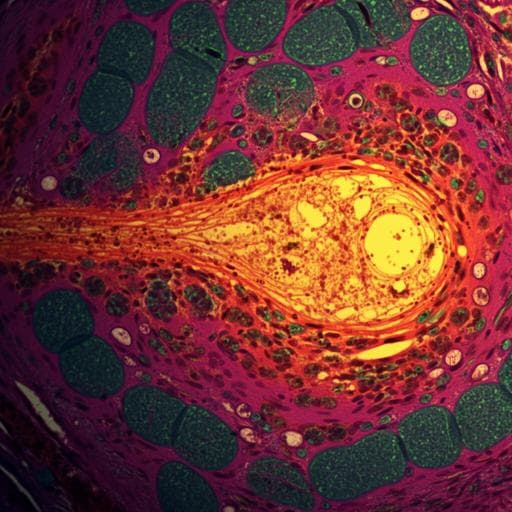
Medicine and Health
Single-cell analysis of two severe COVID-19 patients reveals a monocyte-associated and tocilizumab-responding cytokine storm
C. Guo, H. Ma, et al.
This cutting-edge study by Chuang Guo, Huan Ma, and colleagues delves into single-cell analysis of severe COVID-19 patients, revealing a specific monocyte subpopulation linked to cytokine storms. The research showcases how tocilizumab effectively mitigates inflammation while preserving vital immune responses, paving the way for better treatment strategies against COVID-19's severe complications.
~3 min • Beginner • English
Introduction
As of May 1, 2020, COVID-19 had caused substantial global morbidity and mortality, with approximately 14% of patients developing severe disease and high fatality among critically ill cases, likely linked to dysregulated immune activation. Severe cases are associated with cytokine storms characterized by elevated inflammatory cytokines, including GM-CSF, IL-6, TNF-α, IL-2, IL-7, IL-10, and G-CSF. Prior work implicated peripheral inflammatory monocytes and pathogenic T cells in driving cytokine storms in severe COVID-19. Tocilizumab, an IL-6 receptor–blocking monoclonal antibody, has been used clinically to mitigate cytokine release syndrome and improve outcomes in severe COVID-19, rapidly normalizing fever and reducing cytokines within days. However, mechanisms underlying its effects and whether antiviral immunity is preserved remained unclear. This study uses single-cell RNA sequencing of PBMCs from two severe-stage COVID-19 patients before and after tocilizumab treatment to characterize immune cell changes, identify inflammatory cell subsets, and assess effects on humoral and cellular antiviral responses.
Literature Review
The study builds on reports that cytokine storms contribute to mortality in severe COVID-19, with increased circulating cytokines such as IL-6 and TNF-α. Inflammatory monocytes and activated T cells have been implicated in mediating these storms. Tocilizumab has shown clinical benefit in controlling cytokine-release syndromes and improving severe COVID-19 symptoms and biomarkers within days of administration. Prior single-cell studies highlighted immune dysregulation but the specific monocyte subsets and interaction networks driving the storm, and how IL-6R blockade modulates them while preserving antiviral immunity, required further clarification.
Methodology
- Cohort and sampling: Two severe COVID-19 patients were sampled longitudinally. Peripheral blood was drawn at day 1 (severe stage; within 12 hours of tocilizumab administration), day 5 (remission stage for both patients), and day 7 for one patient (P2) who was still SARS-CoV-2 positive on day 5 but negative on day 7. Clinical laboratory data included lymphocyte counts, neutrophil percentages, C-reactive protein, and IL-6 levels. Both patients were discharged within 8–10 days.
- PBMC isolation and scRNA-seq: PBMCs were isolated and profiled using 10x Genomics single-cell mRNA sequencing.
- Data processing and QC: Cell Ranger (v3.1.0) aligned reads to GRCh38. Using Seurat (v3.1), low-quality cells were filtered (COVID-19 cells kept with 500–6000 UMIs and <10% mitochondrial UMIs; reported healthy donor parameters adjusted per dataset). Doublets were removed using Scrublet (v0.2.1). Post-QC, 13,329 PBMCs from patients remained (4,341 severe; 8,895 remission), with technical and biological replicates showing high reproducibility.
- Integration and clustering: COVID-19 PBMCs were integrated with published healthy PBMCs (total combined cells reported up to 681,190 across datasets) using Seurat (canonical correlation analysis) and visualized via UMAP; Harmony provided corroborative integration. Major immune cell lineages were annotated using canonical markers (monocytes, CD4+ and CD8+ T cells, NK cells, Tregs, B cells, myeloid and plasmacytoid dendritic cells, platelets, and progenitors). Subsets of interest included a monocyte cluster, plasma B cells, effector CD8+ T cells, and proliferative MKI67+ CD8+ T cells.
- Monocyte-focused analyses: 1,677 patient monocytes (916 severe; 761 remission) and 9,517 healthy monocytes were analyzed. UMAP revealed two primary monocyte clusters, including a severe stage–specific subset (cluster 9). Differentially expressed genes (DEGs) were identified via Wilcoxon tests using thresholds (fold change >2, P<0.001, detected in >10% of cells). GO enrichment was conducted using Metascape; results included acute inflammatory response and leukocyte activation pathways.
- Transcription factor and regulatory network inference: SCENIC (v1.1) and RcisTarget were used to infer regulons active in monocytes; TFs such as ATF3, NR1H3, and HIVEP2 were highlighted by AUC scores and motif enrichment in severe-stage monocytes.
- Cell–cell communication: CellPhoneDB was applied to infer cytokine/receptor interactions among monocytes and other immune subsets, focusing on severe vs remission stages and vs healthy controls.
- Comparative datasets: Integration with external scRNA-seq datasets from sepsis patients (mild and severe) and ICU non-sepsis controls assessed whether the severe-stage monocyte subset was unique to COVID-19; COVID-19 severe monocytes overlapped a particular integrated cluster suggestive of uniqueness.
- CD8+ T and B lineage analyses: Subclustering identified naive, effector, and proliferative CD8+ T cells; plasma B cell frequencies and gene expression were compared across stages and healthy controls.
- Statistics: Two-tailed Wilcoxon rank-sum tests for gene expression differences; permutation tests in CellPhoneDB; hypergeometric tests with Benjamini–Hochberg correction for ontology enrichments; additional metrics such as Jaccard index for cluster similarity in Harmony validation.
- Data and code availability: scRNA-seq data deposited at GEO (GSE156881); additional control datasets and code available as cited.
Key Findings
- Identification of a severe-stage specific monocyte subpopulation: A monocyte cluster (cluster 9) comprised 98.3% of monocytes in the severe stage, 12.1% in remission, and 0% in healthy controls, indicating a strong association with severe disease.
- Inflammatory gene program in severe-stage monocytes: Severe-stage monocytes upregulated cytokine and inflammation-related genes, including TNF, IL1B, CCL3, IL6, NLRP3, and IL18 (fold change ≥2; very significant P values), consistent with a cytokine storm phenotype.
- Pathway enrichment: GO terms were enriched for regulation of acute inflammatory response, leukocyte activation, cell adhesion, and cell chemotaxis in severe-stage monocytes (extremely low P values, e.g., P<1e-117 for key terms), supporting their proinflammatory function.
- Regulatory factors: SCENIC analysis highlighted TFs ATF3, NR1H3, and HIVEP2 with enhanced regulon activity and motif enrichment in severe-stage monocytes, suggesting their role in driving the inflammatory program.
- Monocyte-centric cytokine/receptor network: Fifteen cytokine/receptor pairs showed increased interactions in severe-stage patients. Notable interactions included IL-6/IL-6R (monocyte communication with CD4+ T cells and plasma B cells), TNF/TNFR (with CD4+ T, CD8+ T, and B cells), IL-1β/IL-1R (with CD8+ T cells), and chemokines CCL2, CCL3, CCL4 with their receptors, indicating broad proinflammatory crosstalk.
- Tocilizumab effects: After tocilizumab treatment (remission stage), the distribution of several immune subsets (e.g., pDCs, mDCs, monocytes) in peripheral blood became more similar to healthy controls, and the predicted cytokine/receptor interaction activity decreased relative to the severe stage, indicating attenuation of inflammatory signaling.
- Antiviral immune responses preserved: Despite reduced inflammation, plasma B cells were abundant in both severe and remission patients (virtually absent in healthy controls), indicating robust humoral responses. CD8+ T cells displayed increased effector and proliferative signatures (e.g., higher effector markers and MKI67 in subsets), indicating sustained cellular immunity.
- Comparative uniqueness: Integration with sepsis datasets suggested the severe-stage COVID-19 monocyte subset overlapped a distinct integrated cluster potentially unique to COVID-19 pathogenesis.
- Quantitative scope: Overall dataset included 13,329 patient PBMCs (4,341 severe; 8,895 remission). Monocytes analyzed included 1,677 patient monocytes (916 severe; 761 remission) and 9,517 healthy controls.
Discussion
The study addresses how severe COVID-19 elicits pathological inflammation and how IL-6R blockade modulates it. A distinct monocyte subpopulation emerges in the severe stage with a pronounced inflammatory transcriptional program and elevated cytokines and chemokines, aligning with the concept of a monocyte-driven cytokine storm. Regulatory network inference implicates TFs like ATF3, NR1H3, and HIVEP2 in orchestrating this program. CellPhoneDB analyses reveal dense monocyte-centered cytokine/receptor interactions with T and B cells, including IL-6/IL-6R and TNF/TNFR axes, providing a mechanistic basis for immune cell crosstalk in severe disease. Following tocilizumab, inflammatory signatures and aberrant cell distributions partially normalize, consistent with clinical improvement. Importantly, antiviral immunity appears preserved, with abundant plasma B cells and activated/proliferating CD8+ T cells in both severe and remission stages, alleviating concerns that IL-6R blockade might compromise antiviral responses. Collectively, the findings suggest that targeting monocyte-driven cytokine pathways can reduce harmful inflammation while maintaining protective immunity, and highlight specific cytokine/receptor interactions as therapeutic targets.
Conclusion
This work provides a high-resolution single-cell atlas of peripheral immune responses in severe COVID-19 before and after tocilizumab treatment. A severe-stage specific monocyte subset drives a cytokine storm through upregulated inflammatory genes and extensive cytokine/receptor interactions with lymphocytes. Tocilizumab attenuates these inflammatory features and restores immune cell distributions without abrogating humoral or cellular antiviral responses. The study identifies candidate transcriptional regulators (ATF3, NR1H3, HIVEP2) and cytokine/receptor axes (e.g., IL-6/IL-6R, TNF/TNFR, IL-1β/IL-1R, CCL2/3/4 and receptors) as potential therapeutic targets. Future work should validate these findings in larger cohorts, incorporate protein-level and functional assays, perform longitudinal sampling across disease trajectories, and test targeted interventions against the monocyte subset and its signaling pathways.
Limitations
- Small sample size (two patients) limits generalizability and statistical power.
- Observational design with samples collected near the time of tocilizumab administration complicates disentangling treatment effects from natural disease progression.
- scRNA-seq measures mRNA; inferred protein interactions (CellPhoneDB) may not fully reflect protein abundance or activation states.
- Integration of multiple public datasets introduces potential batch effects despite Seurat/Harmony correction.
- The uniqueness of the severe-stage monocyte subset to COVID-19 requires broader validation across diverse cohorts and disease controls.
- Functional roles of predicted TFs and cytokine/receptor interactions were not experimentally validated in vitro or in vivo.
Related Publications
Explore these studies to deepen your understanding of the subject.







